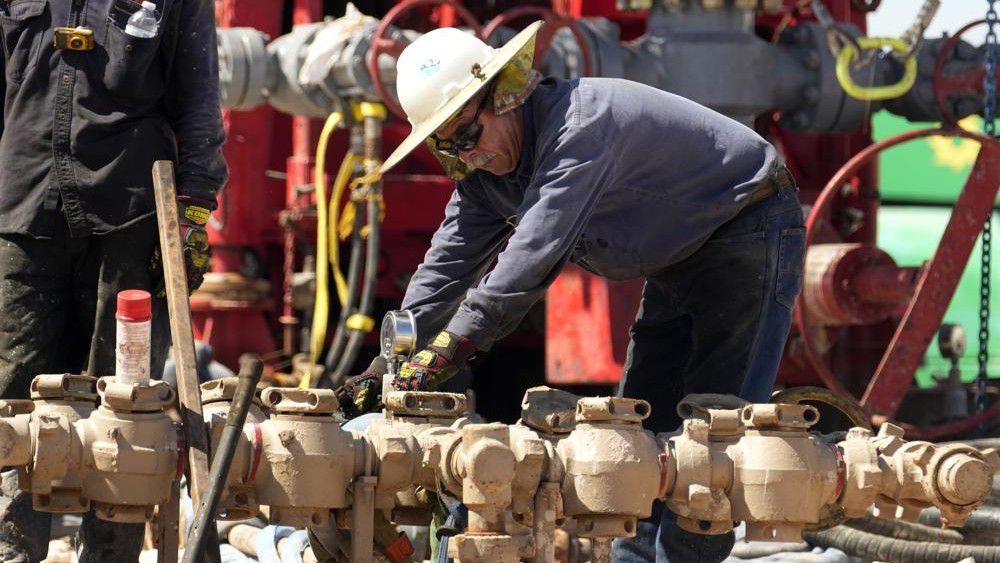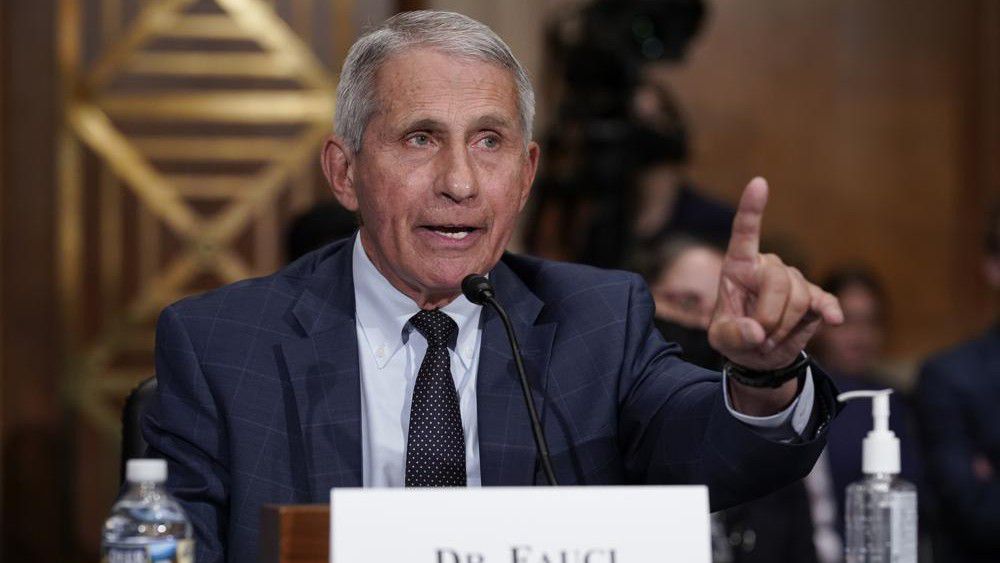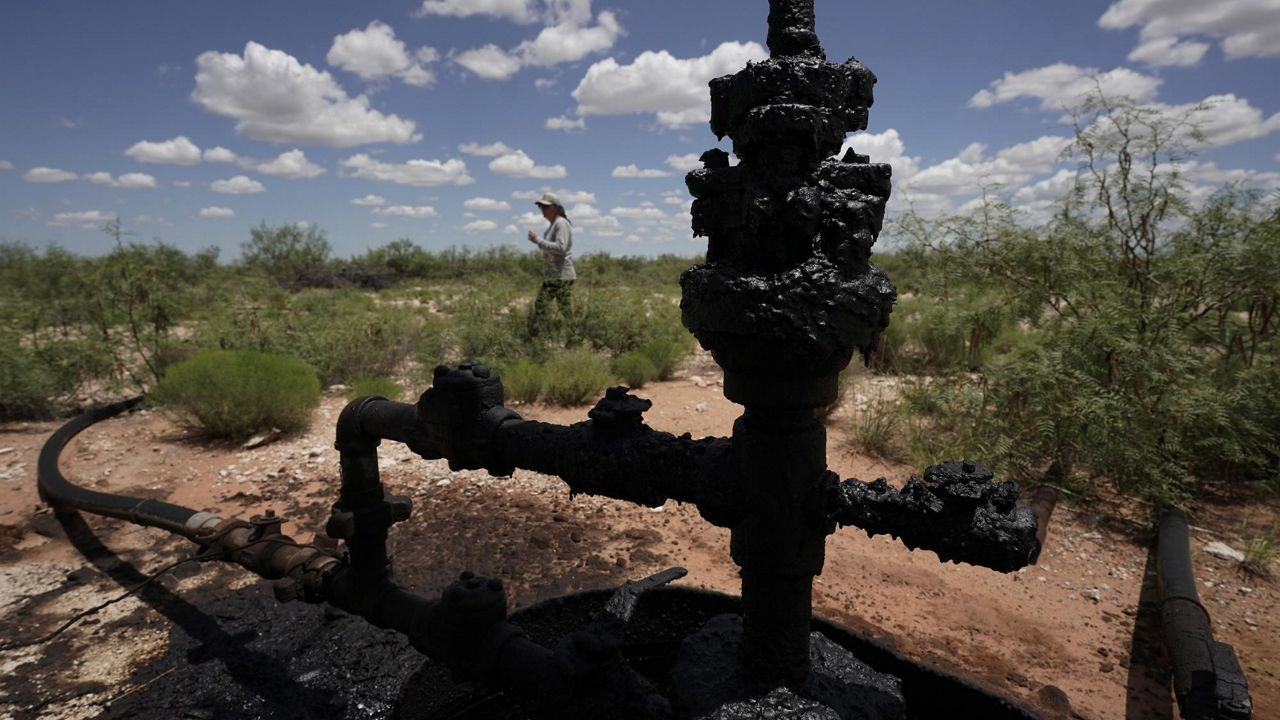CRANE, Texas — Rusted pipes litter the sandy fields of Ashley Williams Watt’s cattle ranch in windswept West Texas. The corroded skeletons are all that remain of hundreds of abandoned oil wells that were drilled long before her family owned the land. The wells, unable to produce any useful amounts of oil or gas, were plugged with cement decades ago and forgotten.
But something eerie is going on beneath the land, where Watt once played among the mesquite trees, jackrabbits and javelina and first drove the dirt roads at 10 years old. One by one, the wells seem to be unplugging themselves. They’re leaking dangerous chemicals that are seeping into groundwater beneath her ranch.
Now 35, Watt believes the problems on her ranch, which sprawls across the oil-rich fields of the Permian Basin, are getting worse. In April, she found crude oil bubbling from an abandoned well. In June, an oil company worker called to alert her that another well was seeping pools of salty produced water, a byproduct of oil and gas extraction containing toxic chemicals.
“I’m watching this well literally just spew brine water into my water table, and then I have to go home at night, and I’m sweaty and tired and smelly, and I get in the shower, and I turn on the shower and I look at it, and I think, is this shower going to kill me?” Watt said.
The crisis unfolding on Watt’s 75,000-acre ranch offers a window on a growing problem for the oil industry and the communities and governments that are often left to clean up the mess. According to the Environmental Protection Agency, 3.2 million abandoned oil and gas wells exist in the United States. About a third of them were plugged with cement, which is considered the proper way to prevent harmful chemical leaks. But most haven’t been plugged at all.

Many of the wells are releasing methane, a greenhouse gas containing about 86 times the climate-warming power of carbon dioxide over two decades. Some are leaking chemicals such as benzene, a known carcinogen, into fields and groundwater.
Regulators don’t know where hundreds of thousands of abandoned wells are because many of them were drilled before modern record-keeping and plugging rules were established. They are a silent menace, threatening to explode or contaminate drinking water and leaking atmosphere-warming fumes each day that they’re unplugged. Without records of their whereabouts, it’s impossible to grasp the magnitude of the pollution or health problems they may be causing.
The problem isn’t confined to Texas. In recent years, abandoned wells have been found under brush deep in forests and beneath driveways in suburbia. On the Navajo Nation, a hiker stumbled across wells oozing brown and black fluid that smelled like motor oil. In Colorado, a basement exploded, killing a man and his brother-in-law who were repairing a water heater, after an abandoned flowline had leaked methane into the house.
A Wyoming school shut down for more than a year after students and teachers complained of headaches for weeks. Air quality tests revealed high levels of benzene and carbon dioxide, most likely from a nearby abandoned oil well. A garage in Pennsylvania exploded — a consequence, the state suspects, of abandoned gas wells.
Experts believe the problem is getting worse. Even before the viral pandemic, producers were declaring bankruptcy and abandoning oil fields after spending more on fracking operations than they ultimately could afford. Then the coronavirus halted travel, obliterating demand for fuel and leaving less money to properly plug wells.
President Joe Biden, who has built much of his domestic policy around a transition to cleaner energy sources, wants to spend billions to put unemployed wildcatters to work plugging the wells. But Congress is unlikely to allocate enough money to seriously confront the issue.
“If, all of a sudden, we could switch to all green renewable energy, that’s great, but these wells don’t disappear; they’re still going to be there,” said Mary Kang, an assistant professor of civil engineering at McGill University in Montreal who was among the first scientists to call attention to the danger of abandoned wells.
After the discoveries on Watt’s ranch, traces of benzene showed up in the well that supplies her cattle’s drinking water. Chevron, which owned at least two of the oil wells that recently came unplugged, began trucking in drinking water while its crews tried to fix the leaks. But Watt worried that her animals might have consumed contaminated water. So she had her 600 head of cattle hauled off to another part of her ranch.
“At this point,” she said, “I cannot sell my cattle at market in good conscience, because I have no idea what is in them.”
Though Chevron officials maintained that the cattle could safely return, Watt disagreed.
She’s haunted by a memory of crude oil bubbling up in a toilet bowl at her family’s ranch when she was a teenager. Horrified, they turned off the well that supplied their water and switched to another well. They never found the source of the leak.
Representatives for Chevron said the company is committed to re-plugging the two wells that recently sprang leaks.

But Watt fears that dozens of other plugged and abandoned wells on her ranch might be deteriorating, and Chevron has no plans to check its other wells for problems. If Watt should inform Chevron of another leaking well, “if we have to take responsibility, we will and we’ll do the right thing by the landowner,” said Catie Mathews, a company spokeswoman.
Hailing from a long line of cattle ranchers, Watt never thought she’d be fighting this fight. After high school, she graduated from the U.S. Naval Academy and worked in intelligence for the Marines. Even after she obtained an MBA from Harvard, she returned to the ranch.
She packs a gun, but only on her own land. Though she’s passionate about protecting it, she doesn’t want to be called an “environmentalist” — that’s a dirty word out here. But she has to save her ranch.
“The story of my family,” Watt said, “is a story of land, if nothing else.”
Dispiriting as her situation is, Watt is luckier than some. She knows Chevron bears responsibility for two wells that recently sprang leaks on her property. But not every well has a clear responsible party. Some abandoned ones are so old and records so scarce that landowners or states are left to clean up the damage.
Molly Rooke, who co-owns a family ranch near Corpus Christi, Texas, faced that predicament in 2019, when an orphaned well blew out on her property, spewing chemicals. The 15,000-acre ranch contained dozens of orphaned wells, with exposed pipes not much taller than her own frame. Some pipes stuck out of the ground. Others were hidden in brush.
“We have problems finding the well head, and that’s above the ground,” Rooke said. “Then you have all these pipes underground, and there’s no record of where those go.”
Her only records of these wells that were drilled in the 1920s were scattered old photos and papers. She tried to contact companies that used to pump oil from the wells. No luck. One well had already leaked into a nearby river.
Rooke’s father tried for years to get the state to plug them. When he died, she took over the fight. Rooke and the consumer rights group Public Citizen sued the Texas Railroad Commission over its decision during the pandemic to suspend rules requiring operators to plug abandoned wells within a year. After her lawsuit sparked attention, the state sealed her wells.
“All the wells were so old, they were ticking time bombs,” Rooke said.
The first successful commercial oil well in the U.S. was drilled in Pennsylvania in 1859. But few detailed records survived that early oil boom, which lasted several decades. Not until a century later would the industry develop modern plugging standards, which require filling abandoned wells with cement to prevent leaks.
These days, some abandoned wells have metal casings intact. But others were stripped of metal during World War II, making them hard to find. Still others were constructed from wood that rotted away and left only a hole in the ground.
Pennsylvania has located roughly 8,700 orphaned wells, mostly unplugged and in rural areas. Yet the problem is far larger. Based on historical photos and surveys, Pennsylvania estimates that between 100,000 and 560,000 additional unplugged wells remain scattered around the state.
“We’re not plugging fast enough to keep up with the wells we’re discovering,” said Seth Pelepko, an environmental program manager in the Pennsylvania Department of Environmental Protection. “Our list is not getting smaller. It’s getting larger.”
Some states have taken to hiring well hunters who specialize in finding abandoned wells. They use metal detectors — first in helicopter surveys, then on the ground — to seek steel well casings. But metal detectors can’t detect wells cased in wood. So they fly drones with laser imaging to seek depressions in the ground.
On her Texas ranch, Watt uses some of the same techniques to seek problematic aging wells. She has driven her land, looking for signs of trouble.
Sometimes, she finds a dark patch of earth using a drone. She calls one of the biggest the “elephant graveyard,” after a wasteland in the movie “The Lion King.” Rather than animal bones, her graveyard contains blackened mesquite trees.
The sand there is dark and reeks of oil. But Watt’s worry is the water below. Without it, she and her longtime ranch foreman, Marty White, and his wife — and their cattle — can’t live here. Water is the lifeblood of this place and all of West Texas.
“I told him, ‘I’ll take care of you,’ ” Watt said of White. “ ‘You’re going to have to trust me, and I don’t know what it looks like, but I’ll take care of you.’"
In addition to polluting groundwater, the wells are accelerating global warming. Unplugged, abandoned wells in the U.S. leaked 5,000 times more methane than plugged wells did, according to a 2015 study cited by the EPA. Unplugged wells leak 280,000 metric tons of methane into the atmosphere each year, according to an estimate by EPA, though experts have estimated far higher totals.
That amount of methane packs roughly the same climate-warming power as the carbon dioxide emitted by all the power plants in Massachusetts in a year, according to Daniel Raimi, a fellow at Resources for the Future, a research group.
Many states require companies to plug wells that are out of production and to post bonds in case they go belly-up. But the amounts are typically far lower than what’s required to plug the wells, leaving states or the federal government with hefty bills.
At the end of June, Texas reported 7,268 orphaned wells, up 17% since 2019. An additional 146,859 were considered “inactive”: They were no longer producing oil, but the owners hadn’t yet been required to plug them. Many inactive wells may actually be orphaned wells, said David Wieland, regional organizer with the Western Organization of Resource Councils, a network of grassroots groups focused on land stewardship. Some producers will let a well sit idle for a year or two, he said, and then produce just enough oil to avoid being required to plug it.
“That sort of hidden inventory is likely true in almost any state,” Wieland said.
Some states, like Texas, use fees collected from the oil and gas industry for cleanups. In 2018 alone, oil-producing states spent $45 million plugging orphaned wells and $7.9 million restoring surrounding land, according to the Interstate Oil and Gas Compact Commission.
As the financial and environmental tolls of abandoned wells grow, policy makers are searching for solutions. In his initial infrastructure proposal, Biden suggested spending $16 billion to put people to work plugging old oil and gas wells and coal mines. Yet even that wouldn’t be nearly enough to solve the problem.
Raimi, of Resources for the Future, estimates that a federal program to plug 62,000 wells over a decade could create 15,000 to 33,000 year-long jobs. At a per-well cost of $76,000, it would take roughly $160 billion to plug all the wells and reclaim the surrounding land, whether it’s companies or governments who pay the price.
Wyoming and North Dakota channeled millions of dollars in federal coronavirus relief funds into employing workers to plug abandoned oil and gas wells over the past year.
Watt’s family never owned the mineral rights to the land and thus never profited from these wells, many of which were drilled in the 1950s and were plugged in the four decades that followed.
She isn’t looking for a drawn-out legal battle with Chevron or any other oil company with wells on her land. She simply wants assurance that the water is safe for her cattle, and the people in her life, to drink. She wants the land to be restored. And she doesn’t know if that’s possible.
“I do not want to sue,” Watt said. “All I want is everything cleaned up.”
Knowing that benzene has seeped into some of her water, she has a nagging suspicion that the rare cancer that killed her mother might have been related to wells leaking toxic chemicals on her ranch. She will likely never know for sure.
But more than anything, she wants justice for the land, her cattle — and the legacy her family bequeathed to her. This is where she spread the ashes of her parents.
“My greatest fear when I lay down every night, even before this well became unplugged, is what if I do something to screw up the history of this ranch, that’s still being written?” Watt asked.
“What if that history ends with me?”



